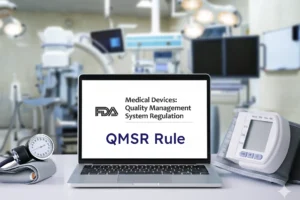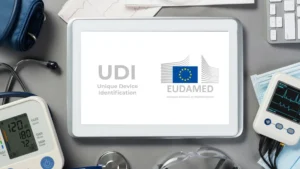In January 2024, the FDA issued a landmark Quality Management System Regulation (QMSR) final rule that overhauls 21 CFR Part 820 to incorporate ISO 13485:2016 by reference.
The FDA explicitly found that, taken in totality, ISO 13485’s requirements are “substantially similar” to the existing QS Regulation and provide a comparable level of assurance for device quality and safety. By basing U.S. regulations on ISO 13485, FDA joins other regulators worldwide (and the Medical Device Single Audit Program) in using this international standard, marking a major step toward regulatory harmonization.
The new rule takes effect on February 2, 2026, providing manufacturers with a two-year transition period to prepare.
Refer Quality Management System Regulation: Final Rule. FAQs
Key Changes Under the QMSR Final Rule
ISO 13485 Integration: The QMSR replaces the old 21 CFR 820 text with ISO 13485:2016 requirements for a medical device quality management system. In practice, firms must ensure their QMS meets ISO’s clauses (from design controls through post-market) while also satisfying unique FDA provisions. Notably, the FDA will not require ISO 13485 certification nor rely on third‑party certificates for inspections.
Additional FDA-Specific Provisions: Because some FDA concepts aren’t explicitly in ISO 13485, the QMSR adds or clarifies terms and expectations. For example, “safety and performance” in ISO is defined as FDA’s “safety and effectiveness,” and ISO’s “rework” definition is limited to pre‑release corrections. The rule also expressly ties ISO clauses to existing regulations: manufacturers must comply with FDA unique device identification (UDI, 21 CFR 830), medical device reporting (MDR, 21 CFR 803), traceability (21 CFR 821), and corrections/removals (21 CFR 806) as applicable.
Design controls continue to apply for Class II/III (and applicable Class I) devices. New record-keeping requirements cover complaint files, servicing records, and UDI data, and allow marking confidential records. Additional device labeling and packaging controls were also inserted.
Inspection and Compliance: On February 2, 2026, the existing Quality System Inspection Technique (QSIT) will be withdrawn, and the FDA will implement a new inspection approach aligned to the QMSR requirements. Importantly, the FDA explicitly states that an ISO 13485 certificate will not exempt a firm from inspection. MDSAP audits remain voluntary and are not a substitute for FDA inspections. Any ISO audits should be viewed as complementary, not as a replacement for FDA oversight.
Two new QMSR training modules were released on the FDA’s CDRH Learn platform recently.
Implications for Manufacturers and Preparing for Compliance
Because the QMSR closely aligns U.S. rules with the international standard, many firms already certified to ISO 13485 will see overlap, but adjustments are still needed.
FDA advises manufacturers to perform a thorough gap analysis between their current QMS (21 CFR 820) and the new QMSR requirements. In practice, this means revising quality procedures, training materials, forms, and supplier/quality agreements to reflect ISO 13485 terminology and the added FDA clauses.
During the two‑year transition period, manufacturers must maintain compliance with the existing QS Regulation while preparing for the QMSR (e.g., addressing any 820 deficiencies under the old rule and updating them to ISO 13485 standards in parallel).
FDA inspectors will expect firms to demonstrate compliance with the new QMSR. The agency notes that investigators may review records created before Feb 2, 2026, to verify they meet the QMSR requirements. In other words, companies should document how past design history files, CAPA records, audit reports, etc., align with the ISO structure.
It is prudent to clearly map existing documents to ISO 13485 clauses and to the FDA-specific provisions. Inspectors will ask questions about your QMS: be ready to show how your process flows, risk management, supplier controls, and post-market surveillance satisfy the harmonized requirements. In short, robust documentation and training now will pay off in smoother audits after the QMSR effective date.
Managing documentation and traceability under the new QMSR framework can be complex. Medical Device Information System (MDIS) helps manufacturers and Economic Operators/medical device partners maintain audit-ready documentation, track UDI/UDI-DI updates, and ensure real-time access to compliant technical files throughout the supply chain. Integrating MDIS into your QMS workflow supports continuous readiness for FDA and ISO 13485 audits.
MedQAIR’s regulatory and QMS experts can guide your transition. We recommend starting now: conduct a detailed gap assessment against ISO 13485:2016 and the FDA’s new clauses, then update your quality manual and procedures accordingly. For example, integrate ISO’s emphasis on risk-based decision-making with your design control process, and ensure all team members understand the updated definitions and new record-keeping obligations. Consider scheduling internal audits or consultant reviews against the QMSR to “preview” how FDA’s new inspection process will apply to you.
With proper planning and documentation, you can achieve a compliant QMS that satisfies both FDA and international requirements.
Next Steps and MedQAIR Support
FDA’s harmonization with ISO 13485:2016 is a major evolution in U.S. device regulation. Companies should treat it as an opportunity to strengthen their quality systems and simplify global market access. MedQAIR’s team of quality and regulatory specialists understands the nuances of the QMSR change.
Contact us to discuss your QMS strategy under the new rule. We can help ensure your transition to the QMSR is efficient, effective, and audit‑ready.





